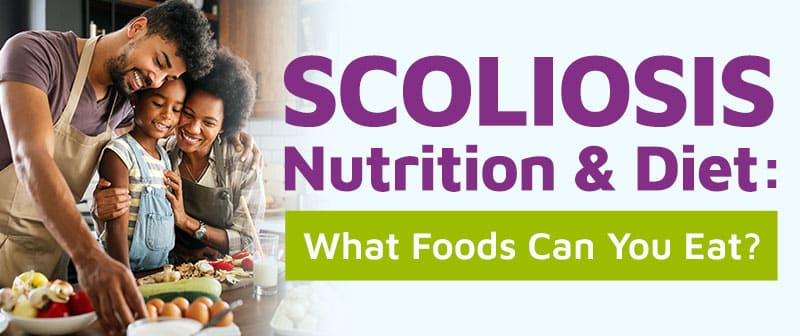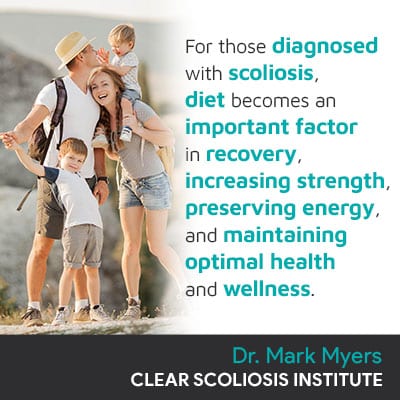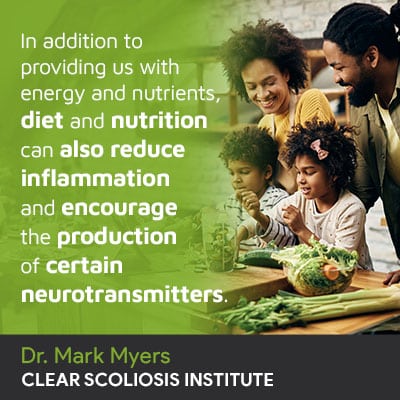
As a structural condition, effective scoliosis treatment has to, first and foremost, impact the condition on a structural level. When treating the whole patient, this includes diet and lifestyle guidance; patients who maintain a healthy weight and diet can minimize the negative aspects of life with scoliosis.
While no dietary changes alone can impact scoliosis on a structural level, which is the first priority of treatment, a healthy diet can make a healthier body, and one that’s more responsive to treatment. In addition, optimal nutrition can help the body become stronger and more conducive to healing.
When it comes to scoliosis nutrition and diet, we’re talking about foods that help the body recover, keep it strong, energetic, and minimize the negative effects of scoliosis, so let’s start with the general connection between scoliosis and diet.
If a person is diagnosed with scoliosis, this means they have an unnatural sideways spinal curve, with a rotational component, and a minimum Cobb angle measurement of 10 degrees.
Scoliosis is structural and progressive, meaning there is an abnormality within the spine itself and that it’s in the condition’s nature to worsen over time, especially if left untreated, or not treated proactively.
While highly treatable, scoliosis is incurable, so those with scoliosis will be living with its effects throughout life, which is why it’s all the more important to know how choices like diet and nutrition can help minimize those effects.

Again, while no diet alone has the potential to correct a scoliosis, in terms of achieving a structural curvature reduction, improvements to diet and nutrition can help improve the body to make it more responsive to treatment and conducive to healing.
When improvements to diet and nutrition are integrated into a proactive treatment plan that impacts the condition on multiple levels, it can help minimize the negative effects of scoliosis, improving quality of life.
So while diet and nutrition, at first thought, might not seem overly related to a structural spinal condition, when combined with a customized and proactive treatment plan, it can have tremendous positive effects.
In addition, there is also the psychological aspect to consider. People diagnosed with a progressive spinal condition have an extra challenge in life, not that scoliosis has to define or limit a person by any means, but energy can be impacted, and in adult scoliosis, pain is the number-one symptom.
The fact that exercise and a healthy diet can lead to increased energy, endorphin production, and improve mental health is positive for everyone, but for those dealing with the added stress of living with a progressive medical condition, the benefits can be more extreme and necessary.
Now that we’ve discussed scoliosis and diet in general terms, let’s get specific about how certain foods can help complement other forms of treatment.
While correcting an abnormal spinal curve on a structural level is always my top treatment priority, once structural issues are addressed, when necessary, diet and nutritional guidance enter shortly thereafter.

Following are some of the ways that diet and nutrition can impact scoliosis positively:
So now that we know the general role that diet and nutrition can play in improving quality of life for people living with scoliosis, let’s discuss specific foods that should, and shouldn't, be included as part of a scoliosis-friendly diet.
While foods high in sugar, salt, and bad fats might taste good and are readily available, especially in the United States, these are the types of foods that are not considered scoliosis-friendly.
The aforementioned types of foods are high in calories, which can lead to obesity, straining the spine, and spinal deterioration, and they can also cause inflammation, as mentioned, which can lead to a loss of bone density.
Following is a list of foods that are not considered part of a scoliosis-friendly diet:
While a complete diet overhaul can produce dramatic results quickly, these types of changes are difficult to sustain, so I help patients decide on where to start for more gradual and sustainable improvements.
I often start with hydration, and replacing pop and juice with water can be a simple, sustainable, and highly-effective change that produces enough results to motivate patients to make additional changes.
For foods that are ideal as part of a scoliosis-friendly diet, increasing fresh fruits and vegetables, lean sources of protein (unprocessed meats, fish, and legumes), foods rich in amino acids, calcium, and vitamin D that are known to promote bone health, and increasing water intake can have positive effects on the body, while minimizing the negative effects of scoliosis.
As mentioned, no dietary changes alone will be enough to correct scoliosis on a structural level, but when integrated into a proactive and customized treatment plan, there are fewer limits to what we can achieve.
As a CLEAR-certified scoliosis chiropractor, the top treatment priority is impacting the condition on a structural level because of its underlying structural nature, and we work towards this through condition-specific chiropractic care.
Through a variety of chiropractic techniques, such as gentle and precise chiropractic adjustments, I can work towards repositioning the most-tilted vertebrae of the scoliotic curve back into alignment with the rest of the spine.
Through the integration of scoliosis-specific exercises (SSEs) and a variety of therapies, core strength can be increased so the spine is optimally supported by its surrounding muscles, and in addition, SSEs are also known to activate certain areas of the brain for better brain-body communication, balance, coordination, and postural remodeling.
Particularly in the treatment of adolescent idiopathic scoliosis, corrective bracing can help augment corrective results by pushing the spine into a corrective position.
Once a condition has been impacted on a structural level, we can address lifestyle issues, such as nutrition and diet, that can help the body restore and heal, while improving spinal strength, function, and overall health and wellness.
When it comes to a scoliosis diagnosis, how a patient responds, in terms of treatment, can have far-reaching effects.
As a structural spinal condition, in order to achieve corrective results, scoliosis has to be impacted on a structural level, and then we can tackle issues like how to cultivate a scoliosis-friendly diet for an internal environment that supports restoration and healing.
At the CLEAR Scoliosis Institute, we believe in the merits of proactive treatment and treating the whole patient, which includes diet and lifestyle guidance when necessary.
When it comes to choosing foods to eat for a scoliosis-friendly diet, we’re talking about fresh fruits, vegetables, lean sources of protein, foods rich in vitamins and minerals for optimal bone health/neurotransmitter production, and drinking lots of water; for what to avoid when you have scoliosis, we’re talking about processed foods high in sugar, salt, fat, alcohol, coffee, and foods associated with inflammation.
As a CLEAR-certified scoliosis chiropractor, I deliver treatment under a conservative chiropractic-centered approach that integrates multiple forms of treatment, including lifestyle guidance, in the hopes of achieving corrective results and preserving optimal spinal function.

CLEAR provides a unique and innovative way of understanding scoliosis. Sign up to receive facts and information you won’t find anywhere else.

Nutrition can also impact how much nutrients you have